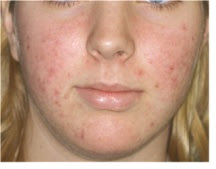Acne vulgaris (cystic acne or simply acne) is a common human skin disease, characterized by areas of skin with seborrhea (scaly red skin), comedones (blackheads and whiteheads), papules (pinheads), pustules (pimples), nodules (large papules) and possibly scarring.
Acne occurs most commonly during adolescence, and often continues into adulthood. In adolescence, acne is usually caused by an increase in testosterone, which accrues during puberty, regardless of sex. For most people, acne diminishes over time and tends to disappear — or at the very least decreases — by age 25. There is, however, no way to predict how long it will take to disappear entirely, and some individuals will carry this condition well into their thirties, forties, and beyond.
Common causes of Acne Vulgaris
- Increased androgen production
- Overactivity/hyperresponsiveness of sebaceous glands in response to androgens
- Colonization of Propionibacterium acnes, which metabolizes sebum to free fatty acid, leading to inflammatory lesions.
5 Nursing Diagnosis for Acne Vulgaris
1. Body image disturbance related to inflammatory lesions of acne.
2. Anxiety related to acne lesions.
3. Impaired skin integrity characterized by erythematous papules, pustules, and cysts inflammatory.
4. Risk for infection related to a bacterial skin infection.
5. Knowledge deficit related to acne triggers and treatments.
